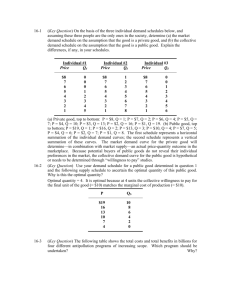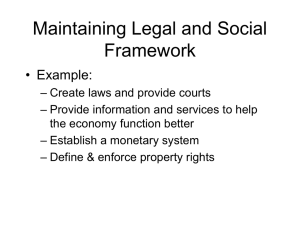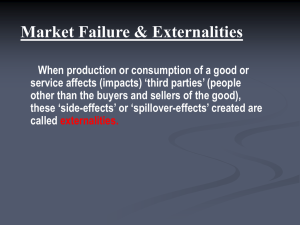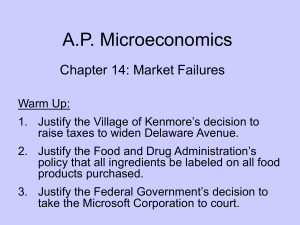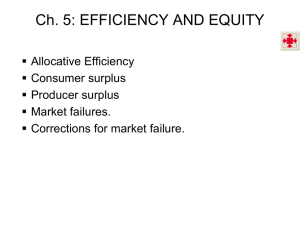Topic 7 notes
advertisement
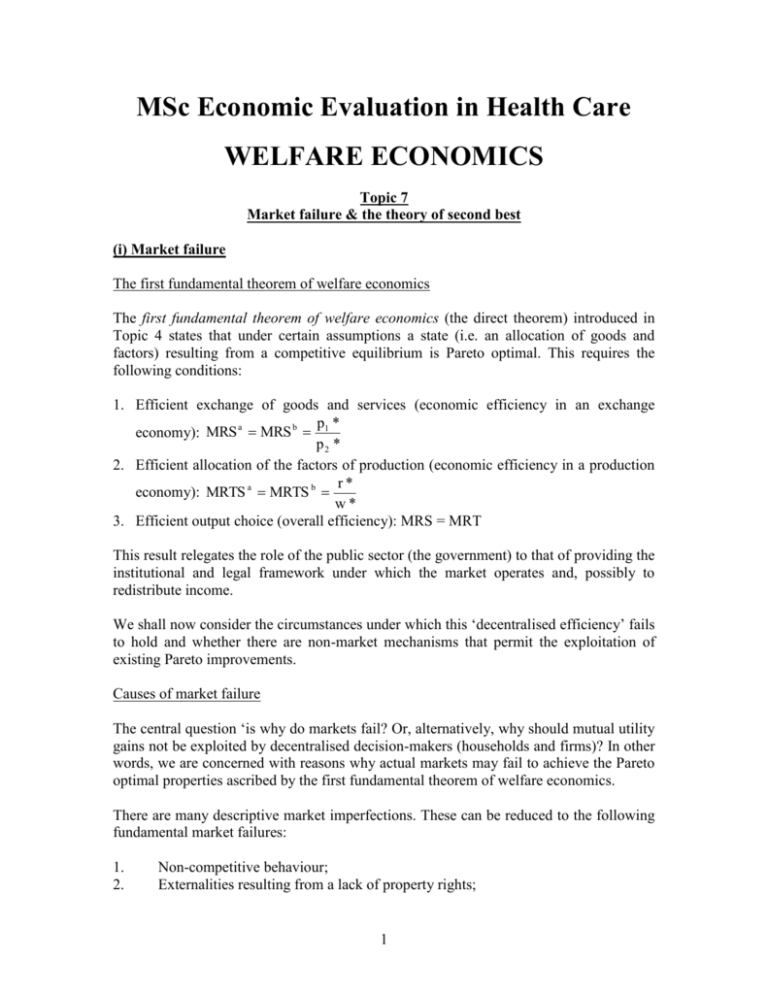
MSc Economic Evaluation in Health Care WELFARE ECONOMICS Topic 7 Market failure & the theory of second best (i) Market failure The first fundamental theorem of welfare economics The first fundamental theorem of welfare economics (the direct theorem) introduced in Topic 4 states that under certain assumptions a state (i.e. an allocation of goods and factors) resulting from a competitive equilibrium is Pareto optimal. This requires the following conditions: 1. Efficient exchange of goods and services (economic efficiency in an exchange p * economy): MRS a MRS b 1 p2 * 2. Efficient allocation of the factors of production (economic efficiency in a production r* economy): MRTS a MRTS b w* 3. Efficient output choice (overall efficiency): MRS = MRT This result relegates the role of the public sector (the government) to that of providing the institutional and legal framework under which the market operates and, possibly to redistribute income. We shall now consider the circumstances under which this ‘decentralised efficiency’ fails to hold and whether there are non-market mechanisms that permit the exploitation of existing Pareto improvements. Causes of market failure The central question ‘is why do markets fail? Or, alternatively, why should mutual utility gains not be exploited by decentralised decision-makers (households and firms)? In other words, we are concerned with reasons why actual markets may fail to achieve the Pareto optimal properties ascribed by the first fundamental theorem of welfare economics. There are many descriptive market imperfections. These can be reduced to the following fundamental market failures: 1. 2. Non-competitive behaviour; Externalities resulting from a lack of property rights; 1 3. 4. Externalities resulting from jointness in consumption and production, including public goods; and, Informational externalities. 1. Non-competitive behaviour An important feature underlying the first fundamental theorem of welfare economics is that all of the participants are price-takers. This means that households and firms do not influence market prices. This is reasonable only if the market is populated with many buyers and sellers. In many cases there may be sufficiently few buyers and sellers that they are aware that their actions can alter market prices. The extreme cases are that of a single seller (a monopoly) and a single buyer (a monopsony) faced by price-taking agents on the other side of the market. The implications of price-setting power: P ≠ MC Supernormal profits may be earned by firms (monopoly, oligopoly) Firms may not operate at the minimum average cost (monopolistic competition) 2. Externalities resulting from a lack of property rights Whenever an activity by one agent influences the output or utility of another agent and this effect is not priced by the market an externality is said to exist. In order for the decentralised market to work, firms and households must be able to exchange claims on the right to use a factor of production or consume a good. This requires a well-defined system of property rights that excludes agents from using a good or factor for which they have not paid. For many goods and factors of production it is prohibitively costly or not feasible to enforce property rights. With common property, some agents may be unable to appropriate all of the returns to a productive activity in which they engage or, alternatively, other agents can free ride and enjoy the fruits of another’s labour and expense. A common property resource exists because property rights are not assigned. One obvious solution is to assign property rights, either in the form of consumption or production limits or to charge a price equal to the scarcity value. Externalities arising from a lack of property rights in health care. Assume a small, positive, constant marginal cost for the consumption of health care (shown by the marginal cost [MC] curve). The marginal benefit (MB) curve for the consumption of health care is downward sloping and the actual quantity of health care consumed occurs where the MB curve crosses the MC curve (at x P). However, this is in fact a private MB curve (MBP) and the social MB (MBS) curve is in fact lower at all quantities of health care consumed (or at least at all higher quantities of health care 2 consumed). Therefore the social optimum would be to consume less health care, where the MBS curve crosses the MC curve (at xS). This can be achieved by imposing a consumption limit equal to xS or setting a higher price so that xS is achieved using the private MB curve. 3. Externalities resulting from jointness in consumption and production, including public goods Externalities may also arise from jointness in consumption and production. Jointness in consumption means that a consumption activity taken by one household affects the utility of one or more other household. Jointness of production occurs when one firm’s activity affects the production possibilities of one or more other firms. The externality may be positive or negative. It may also be unilateral or reciprocal. The externality may also occur among households, among producers, or between households and producers. The first fundamental theorem of welfare economics will generally fail in the presence of externalities arising from jointness in consumption and production. This is because decentralised households and firms in a competitive economy will not take account of the external costs and benefits of their actions when making their (selfish) decisions. With externalities arising from jointness in consumption the exchange efficiency conditions are not satisfied. For example, suppose an economy where n goods (x 1, x2, …xn) are consumed. Also suppose that the consumption of x1 by household A also affects the utility of household B. This means that the utility functions of household A (UA) and household B (UB) may be summarised as follows: UA = f(x1A, x2A, …xnA) UB = g(x1B, x2B, …xnB, x1A) [1] However, household A neglects the influence of its consumption of x1 on household B. That influence may be positive or negative depending on whether the effect is an external economy or an external diseconomy. An analogous problem arises with externalities arising from jointness in production. Externalities resulting from jointness in consumption and production in health care. Assume a small, positive, constant marginal cost for the consumption of health care (shown by the marginal cost [MC] curve). The marginal benefit (MB) curve for the consumption of health care is downward sloping and the actual quantity of health care consumed occurs where the MB curve crosses the MC curve. For household A this occurs at xA, where the MB curve for household A, MBA, crosses the MC curve. However, this level of consumption ignores the benefit to household B from household A’s consumption of health care. This is shown by household B’s MB curve (MBB). Therefore the socially optimal consumption of health care by household A would in fact 3 be xS (which is greater than xA) shown by the intersection of the MBA+MBB curve with the MC curve. A similar analysis may be applied when the externality has a negative effect, in which case MBB would be negative and the socially optimal output xS would be below household A’s optimum xA. Where there exists positive externalities arising from jointness in the consumption of goods such as health care due to altruism, then the result is a caring externality. Such caring externalities may also be reciprocal across households. An extreme case of jointness in consumption and production occurs with public goods. Public goods have two related features: 1. Non-excludability, which means that my consumption of the good does not exclude your consumption of it; and, 2. Non-rivalry, which means that my consumption of the good does not decrease the amount of it left for you. Goods that possess both these qualities are known as pure public goods. Goods which possess exactly the opposite qualities (excludability and rivalry) are known as pure private goods. Goods which are neither purely public or purely private are called mixed public goods. Mixed public goods are subject to congestion costs as the number of users/consumers increases, where it is useful to think of congestion costs as altering either the quality of the good or the amount of the good per user. Health care provision may be thought of as a mixed public good because to a certain extent it is characterised by non-excludability and non-rivalry with congestion costs. Households who receive benefits without paying for them are called free riders, and they are an important reason why the market fails to provide public goods in a Pareto optimal manner. If the provision were left to the market place then public goods would be underprovided. The reason is that individuals have incentives to understate their own preferences in order to avoid paying and free-ride on the demands for others. 4. Informational externalities The efficiency of the competitive market equilibrium depends on all of the decentralised decision-makers (households and firms) having full information. The market itself plays an important role in conveying information in the form of relative prices to decisionmakers about the relative costs and benefits of different actions. However, informational externalities may arise due to asymmetric information in the market. Two important sources of informational externality are: 1. Adverse selection. This is one example of an informational externality, when one side of the market is more informed about the nature of the exchange being made. Examples of adverse selection include the market for ‘lemons’, labour markets, and the market for health insurance. One solution to the adverse selection problem is 4 through signalling, where the more informed party attempts to inform the less informed party by sending a signal. 2. Moral hazard is another example of an informational externality, where a problem of excess use arises because the informed party brings about a level of provision (demand or supply) of the good that is greater than the level of provision that would have been achieved had both parties been equally well informed. Market failure and the role of the public sector We have discussed the important reasons why a Pareto optimal allocation of scarce resources may not be achieved through the decentralised market system. In all cases of market failure the marginal social benefit of devoting an extra unit of resources to a particular activity will differ from the marginal social cost. Market participants, motivated by private rather than social marginal costs and benefits will not be induced to devote the optimal amount of resources to the activity. In some case there will be too few resources used (in the case of public goods and positive externalities), in other cases there will be too many resources used (in the case of non-competitive behaviour via barriers to entry and negative externalities). In the face of market failure there may exist a role for the public sector over and above that of providing the institutional and legal framework under which the market operates and redistributing income. The government may have to involve itself in the actual allocation of resources. A key question is why should the government be able to take mutually beneficial allocative actions which private agents (households and firms) cannot? The answer lies in the government’s monopoly in the legal use of coercive power: the government can extract involuntary payments and prohibit activities with the threat of force. However, while market failures indicate a possible role for the government this is not to say that the government should necessarily intervene in the market. To warrant intervention, the government must have at its disposal means that are capable of producing a Pareto improvement. Also, even if such means are available there is still the question of whether or not governments will work in the way that we hope they will in order to produce a Pareto improvement: just as there are potential failures in the way that decentralised markets work, so there are political processes and bureaucratic structures that may cause government failures. (ii) The Theory of Second Best The first-best allocation of resources The first fundamental theorem of welfare economics (the direct theorem) states that under certain assumptions a state (i.e. an allocation of goods and factors) resulting from a competitive equilibrium is Pareto optimal. This requires the following conditions: 5 1. Efficient exchange of goods and services (economic efficiency in an exchange p * economy): MRS a MRS b 1 p2 * 2. Efficient allocation of the factors of production (economic efficiency in a production r* economy): MRTS a MRTS b w* 3. Efficient output choice (overall efficiency): MRS = MRT If these three conditions are met, we will achieve what is called the first-best allocation of resources (i.e. those implied by the three conditions for Pareto optimality – the ‘first-best’ rules). Market failure Unfortunately, in reality many sectors of a large economy will deviate from the first-best rules due to market failure and so the first-best allocation of resources will not be achieved. Such market failures imply a potential role for government intervention to allocate resources (in addition to providing the institutional and legal framework under which the market operates and, possibly, to redistribute income). By intervening appropriately in sectors of the economy where the first-best allocation of resources is not achieved through the use of taxes, subsidies, regulations and/or public production decisions the government may be able to allocate resources in such a way so as to improve social welfare. The second-best allocation of resources Given that the first-best allocation will not be achieved, this leads us to the next logical question: given that such imperfections are inherent in the economy, do we achieve the second-best allocation of resources (i.e. the best feasible one given the existence of market failures) by following the first-best rules whenever possible? This would mean allowing the unconstrained sectors of the economy (those without market failures) to be organised in the perfectly competitive manner discussed previously in an effort to achieve the first-best rules in those sectors. Unfortunately the answer to this question is no. This is the theory of second best: accept as a constraint that one or more of the necessary conditions for Pareto optimality are violated in an economy. Then meeting the other necessary conditions in the rest of the economy is generally not desirable on Pareto optimality grounds. Interpretation of the theory of second best The theory of second best implies that perfect competition with no policy intervention in the unconstrained sectors does not lead to the best feasible allocation of resources. This clearly has implications for the appropriateness of piecemeal (single-sector) policies, and 6 illustrates a general second-best result: in theory we can do better by policy intervention in the market price setting process than the market would do on its own. This has very negative implications for welfare economics. It means that the intuitively simple ideas captured in the first-best rules cannot be relied upon without reservations. Also, the rules for optimality under second-best conditions are far more complicated and difficult than the first-best rules. Clearly this introduces a further role for government intervention over-and-above regulating market failures directly, providing the institutional and legal framework under which the market operates and, possibly, redistributing income: there is an argument for government intervention in price setting even in unconstrained sectors of the economy. 7
